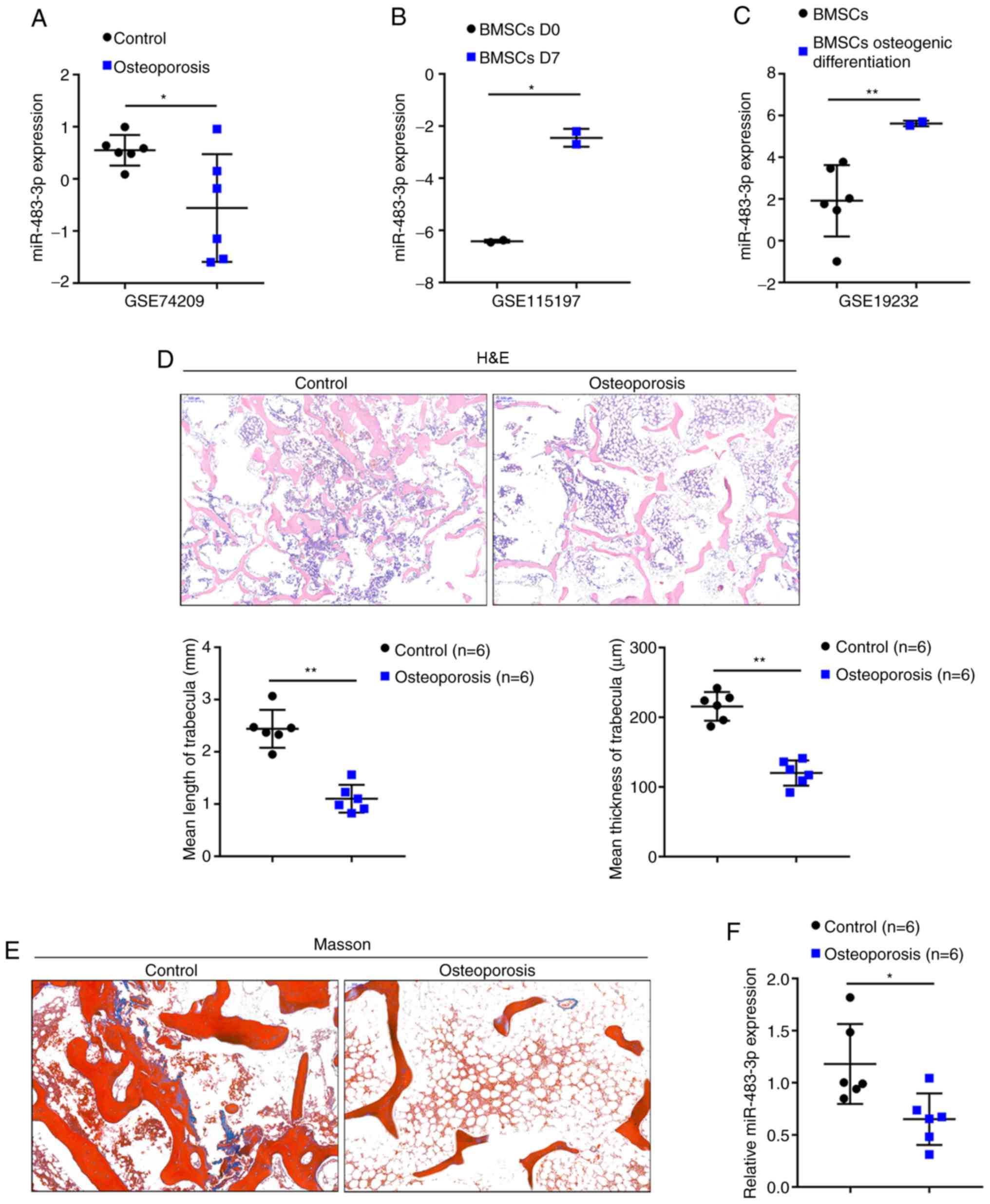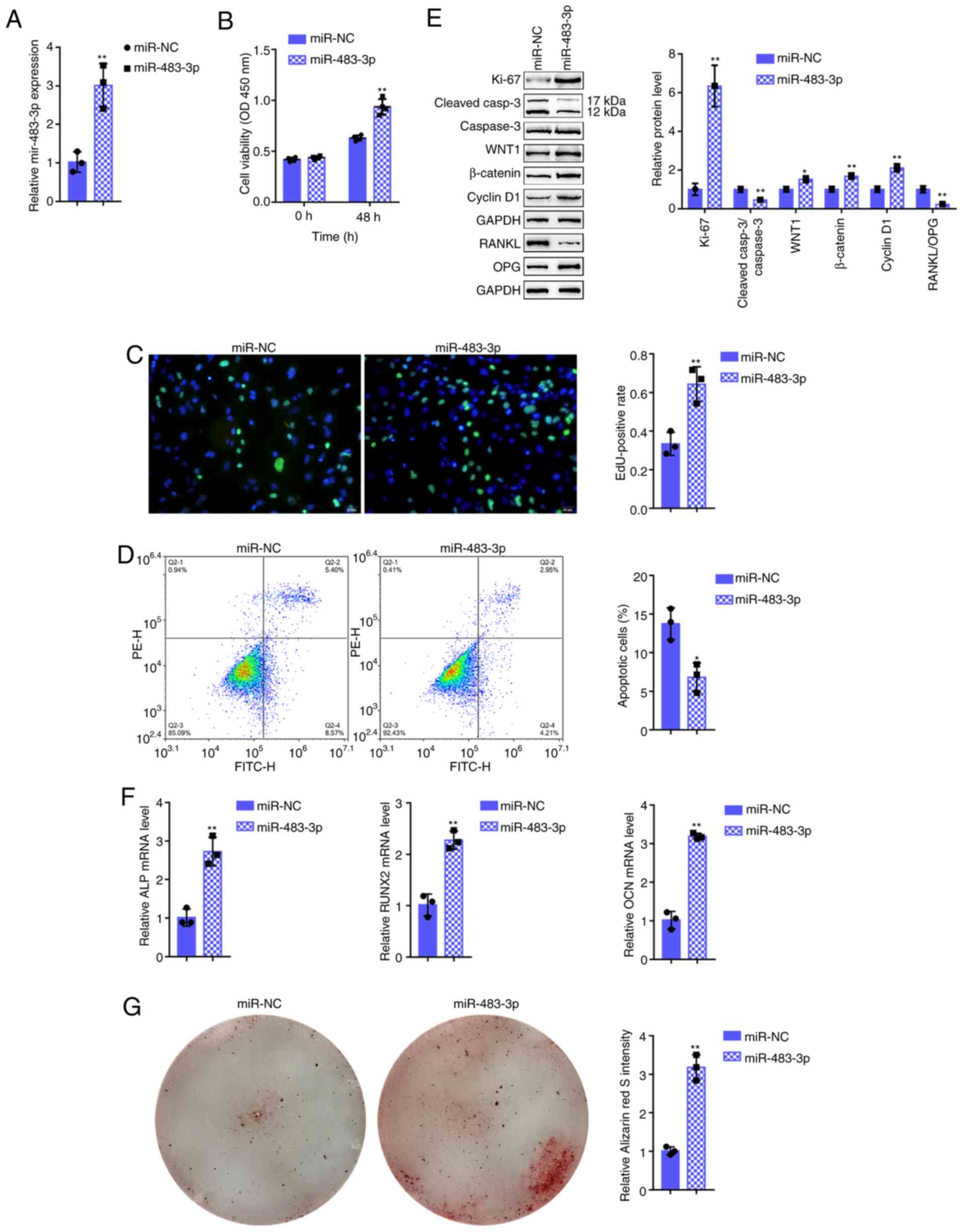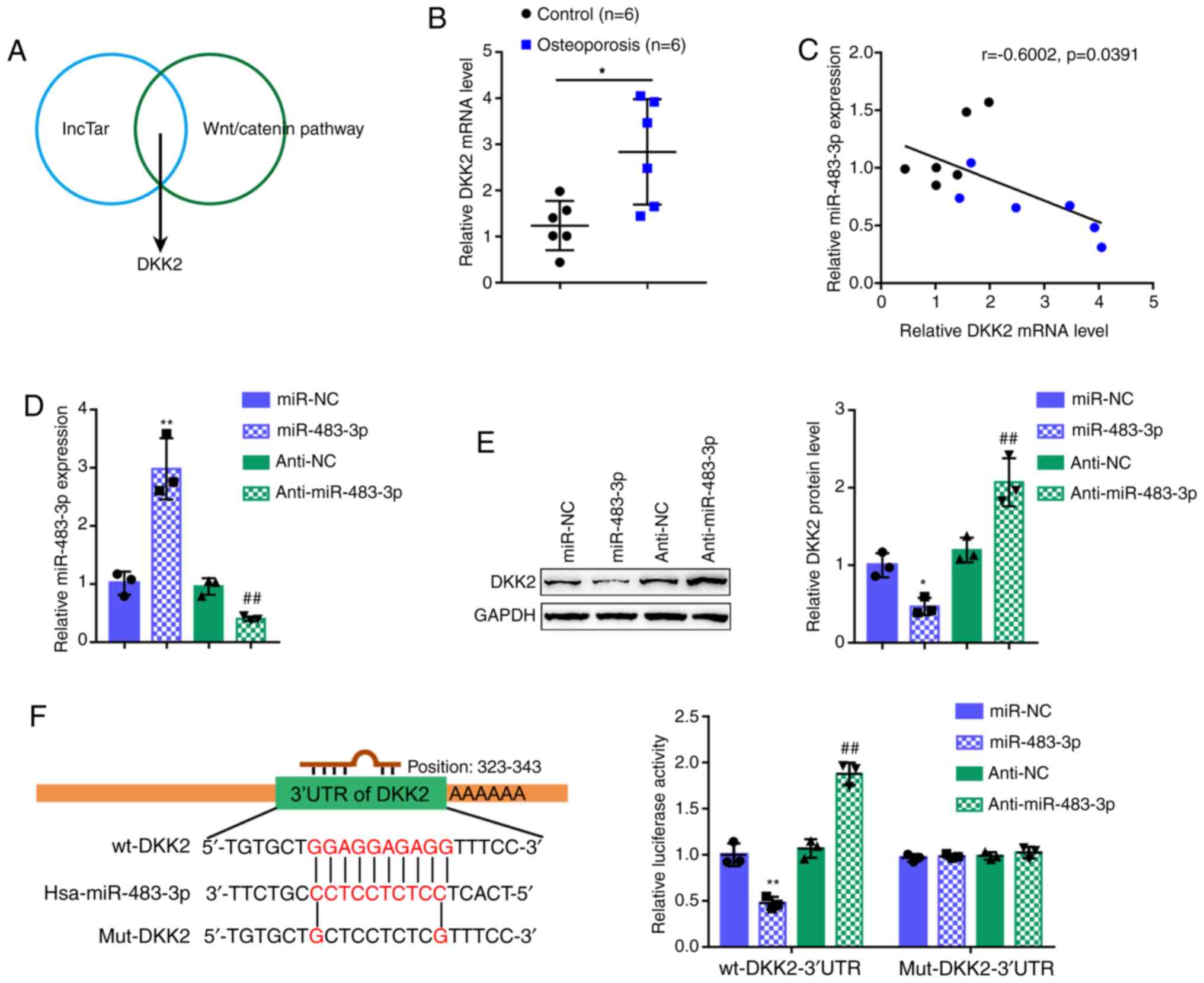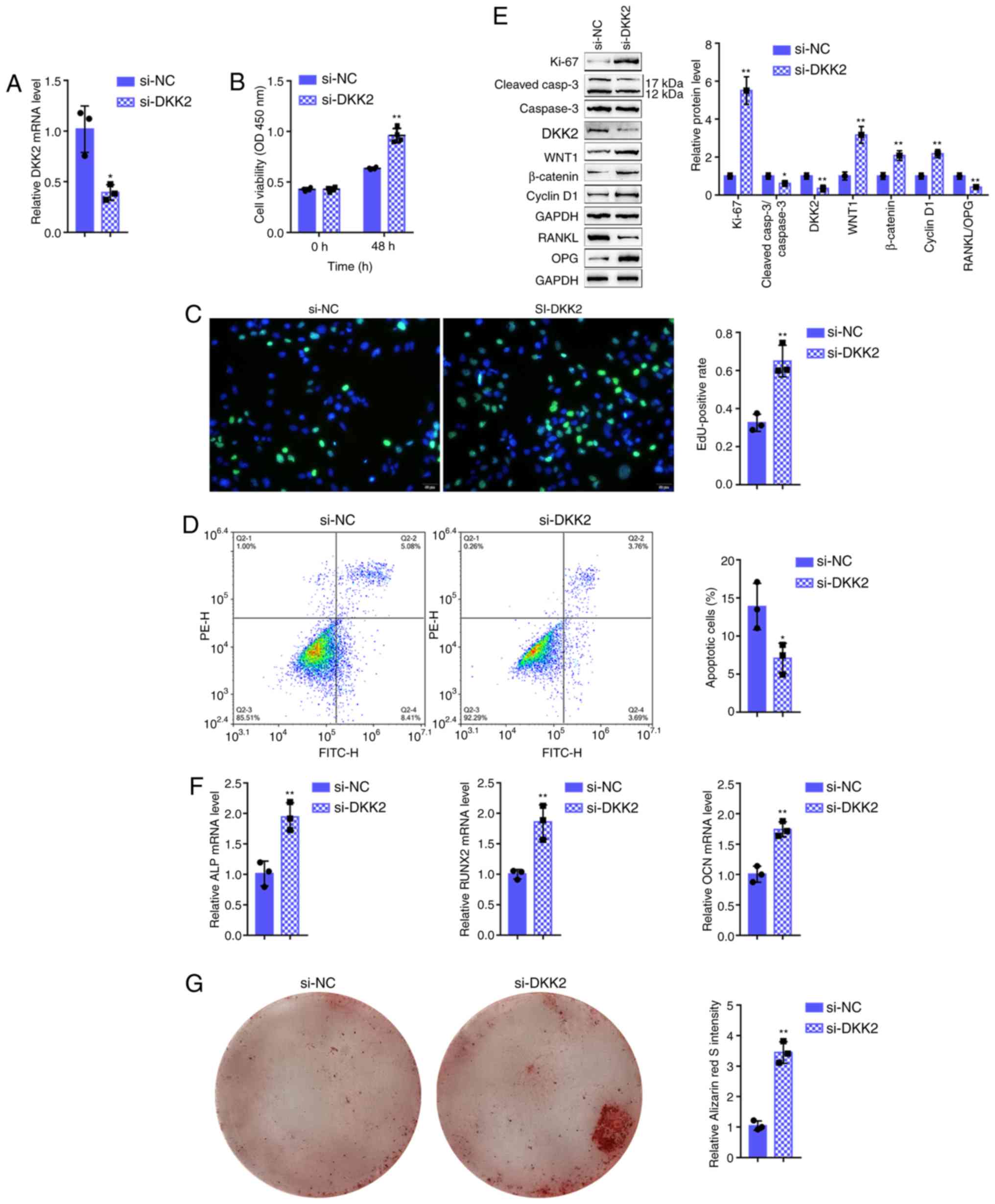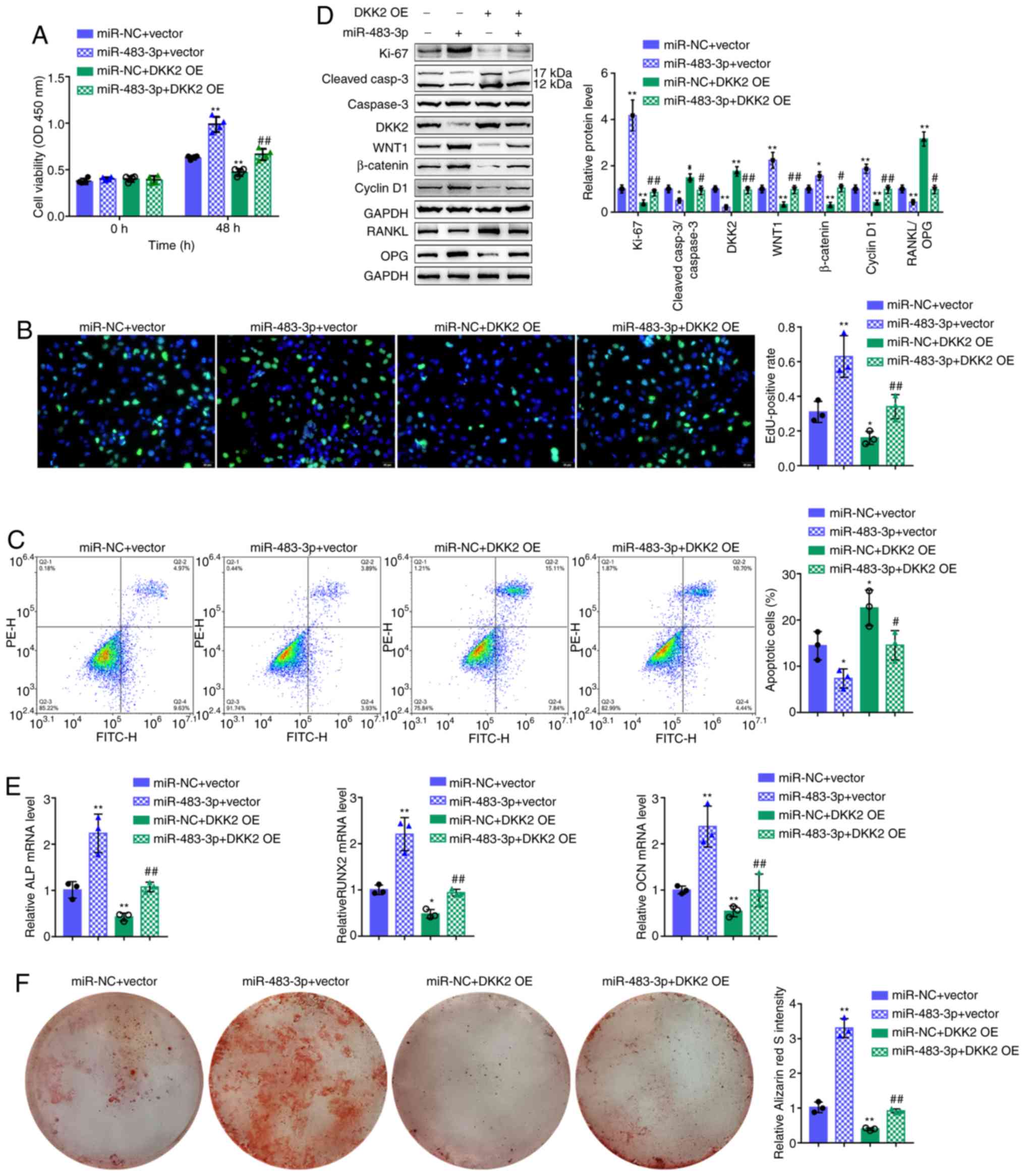|
1
|
Armas LA and Recker RR: Pathophysiology of
osteoporosis: New mechanistic insights. Endocrinol Metab Clin North
Am. 41:475–486. 2012. View Article : Google Scholar : PubMed/NCBI
|
|
2
|
Bidwell JP, Alvarez MB, Hood M Jr and
Childress P: Functional impairment of bone formation in the
pathogenesis of osteoporosis: The bone marrow regenerative
competence. Curr Osteoporos Rep. 11:117–125. 2013. View Article : Google Scholar : PubMed/NCBI
|
|
3
|
Khosla S, Melton LJ III and Riggs BL: The
unitary model for estrogen deficiency and the pathogenesis of
osteoporosis: Is a revision needed? J Bone Miner Res. 26:441–451.
2011. View
Article : Google Scholar
|
|
4
|
Xie Z and Chen Y, Gurbuz S, Zhang B, Li Y,
Bai F and Chen Y: Effects of teriparatide in Chinese and Caucasian
women with osteoporosis: Bridging study on efficacy. Clin Interv
Aging. 14:959–968. 2019. View Article : Google Scholar : PubMed/NCBI
|
|
5
|
An J, Yang H, Zhang Q, Liu C, Zhao J,
Zhang L and Chen B: Natural products for treatment of osteoporosis:
The effects and mechanisms on promoting osteoblast-mediated bone
formation. Life Sci. 147:46–58. 2016. View Article : Google Scholar : PubMed/NCBI
|
|
6
|
Komori T: Signaling networks in
RUNX2-dependent bone development. J Cell Biochem. 112:750–755.
2011. View Article : Google Scholar : PubMed/NCBI
|
|
7
|
Guntur AR and Rosen CJ: IGF-1 regulation
of key signaling pathways in bone. Bonekey Rep. 2:4372013.
View Article : Google Scholar :
|
|
8
|
Kobayashi Y, Uehara S, Udagawa N and
Takahashi N: Regulation of bone metabolism by Wnt signals. J
Biochem. 159:387–392. 2016. View Article : Google Scholar :
|
|
9
|
Takahashi N, Maeda K, Ishihara A, Uehara S
and Kobayashi Y: Regulatory mechanism of osteoclastogenesis by
RANKL and Wnt signals. Front Biosci (Landmark Ed). 16:21–30. 2011.
View Article : Google Scholar
|
|
10
|
Landgraf P, Rusu M, Sheridan R, Sewer A,
Iovino N, Aravin A, Pfeffer S, Rice A, Kamphorst AO, Landthaler M,
et al: A mammalian microRNA expression atlas based on small RNA
library sequencing. Cell. 129:1401–1414. 2007. View Article : Google Scholar : PubMed/NCBI
|
|
11
|
Sun X, Guo Q, Wei W, Robertson S, Yuan Y
and Luo X: Current progress on MicroRNA-based gene delivery in the
treatment of osteoporosis and osteoporotic fracture. Int J
Endocrinol. 2019:67826532019. View Article : Google Scholar : PubMed/NCBI
|
|
12
|
Liu H, Liu Q, Wu XP, He HB and Fu L:
MiR-96 regulates bone metabolism by targeting osterix. Clin Exp
Pharmacol Physiol. 45:602–613. 2018. View Article : Google Scholar
|
|
13
|
Xia Z, Chen C, Chen P, Xie H and Luo X:
MicroRNAs and their roles in osteoclast differentiation. Front Med.
5:414–419. 2011. View Article : Google Scholar : PubMed/NCBI
|
|
14
|
Kapinas K, Kessler C, Ricks T, Gronowicz G
and Delany AM: MiR-29 modulates Wnt signaling in human osteoblasts
through a positive feedback loop. J Biol Chem. 285:25221–25231.
2010. View Article : Google Scholar : PubMed/NCBI
|
|
15
|
Hassan MQ, Maeda Y, Taipaleenmaki H, Zhang
W, Jafferji M, Gordon JA, Li Z, Croce CM, van Wijnen AJ, Stein JL,
et al: MiR-218 directs a Wnt signaling circuit to promote
differentiation of osteoblasts and osteomimicry of metastatic
cancer cells. J Biol Chem. 287:42084–42092. 2012. View Article : Google Scholar : PubMed/NCBI
|
|
16
|
Zhang WB, Zhong WJ and Wang L: A
signal-amplification circuit between miR-218 and Wnt/β-catenin
signal promotes human adipose tissue-derived stem cells osteogenic
differentiation. Bone. 58:59–66. 2014. View Article : Google Scholar
|
|
17
|
Xu X, Jiang H, Li X, Wu P, Liu J, Wang T,
Zhou X, Xiong J and Li W: Bioinformatics analysis on the
differentiation of bone mesenchymal stem cells into osteoblasts and
adipocytes. Mol Med Rep. 15:1571–1576. 2017. View Article : Google Scholar : PubMed/NCBI
|
|
18
|
Martin EC, Qureshi AT, Dasa V, Freitas MA,
Gimble JM and Davis TA: MicroRNA regulation of stem cell
differentiation and diseases of the bone and adipose tissue:
Perspectives on miRNA biogenesis and cellular transcriptome.
Biochimie. 124:98–111. 2016. View Article : Google Scholar
|
|
19
|
Tornero-Esteban P, Rodriguez-Rodriguez L,
Abasolo L, Tomé M, López-Romero P, Herranz E, González MA, Marco F,
Moro E, Fernández-Gutiérrez B and Lamas JR: Signature of microRNA
expression during osteogenic differentiation of bone marrow MSCs
reveals a putative role of miR-335-5p in osteoarthritis. BMC
Musculoskelet Disord. 16:1822015. View Article : Google Scholar : PubMed/NCBI
|
|
20
|
Xie F, Zhou B, Wang J, Liu T, Wu X, Fang
R, Kang Y and Dai R: Microstructural properties of trabecular bone
autografts: Comparison of men and women with and without
osteoporosis. Arch Osteoporos. 13:182018. View Article : Google Scholar : PubMed/NCBI
|
|
21
|
Lu J, Yang J, Zheng Y, Chen X and Fang S:
Extracellular vesicles from endothelial progenitor cells prevent
steroid-induced osteoporosis by suppressing the ferroptotic pathway
in mouse osteoblasts based on bioinformatics evidence. Sci Rep.
9:161302019. View Article : Google Scholar : PubMed/NCBI
|
|
22
|
Livak KJ and Schmittgen TD: Analysis of
relative gene expression data using real-time quantitative PCR and
the 2(-Delta Delta C(T)) method. Methods. 25:402–408. 2001.
View Article : Google Scholar
|
|
23
|
Zhang F, Cao K, Du G, Zhang Q and Yin Z:
MiR-29a promotes osteoblast proliferation by downregulating DKK-1
expression and activating Wnt/β-catenin signaling pathway. Adv Clin
Exp Med. 28:1293–1300. 2019. View Article : Google Scholar : PubMed/NCBI
|
|
24
|
Ye W, Wang Y, Mei B, Hou S, Liu X, Wu G,
Qin L, Zhao K and Huang Q: Computational and functional
characterization of four SNPs in the SOST locus associated with
osteoporosis. Bone. 108:132–144. 2018. View Article : Google Scholar : PubMed/NCBI
|
|
25
|
Tang X, Lin J, Wang G and Lu J:
MicroRNA-433-3p promotes osteoblast differentiation through
targeting DKK1 expression. PLoS One. 12:e01798602017. View Article : Google Scholar : PubMed/NCBI
|
|
26
|
Zhang J, Tu Q, Bonewald LF, He X, Stein G,
Lian J and Chen J: Effects of miR-335-5p in modulating osteogenic
differentiation by specifically downregulating Wnt antagonist DKK1.
J Bone Miner Res. 26:1953–1963. 2011. View
Article : Google Scholar : PubMed/NCBI
|
|
27
|
Zhang X, Zhu Y, Zhang C, Liu J, Sun T, Li
D, Na Q, Xian CJ, Wang L and Teng Z: MiR-542-3p prevents
ovariectomy-induced osteoporosis in rats via targeting SFRP1. J
Cell Physiol. 233:6798–6806. 2018. View Article : Google Scholar : PubMed/NCBI
|
|
28
|
Li K, Chen S, Cai P, Chen K, Li L, Yang X,
Yi J, Luo X, Du Y and Zheng H: MiRNA-483-5p is involved in the
pathogenesis of osteoporosis by promoting osteoclast
differentiation. Mol Cell Probes. 49:1014792020. View Article : Google Scholar
|
|
29
|
Rahmanzadeh R, Huttmann G, Gerdes J and
Scholzen T: Chromophore-assisted light inactivation of pKi-67 leads
to inhibition of ribosomal RNA synthesis. Cell Prolif. 40:422–430.
2007. View Article : Google Scholar : PubMed/NCBI
|
|
30
|
Scholzen T and Gerdes J: The Ki-67
protein: From the known and the unknown. J Cell Physiol.
182:311–322. 2000. View Article : Google Scholar : PubMed/NCBI
|
|
31
|
Boatright KM and Salvesen GS: Mechanisms
of caspase-activation. Curr Opin Cell Biol. 15:725–731. 2003.
View Article : Google Scholar : PubMed/NCBI
|
|
32
|
Ghavami S, Hashemi M, Ande SR, Yeganeh B,
Xiao W, Eshraghi M, Bus CJ, Kadkhoda K, Wiechec E, Halayko AJ and
Los M: Apoptosis and cancer: Mutations within caspasegenes. J Med
Genet. 46:497–510. 2009. View Article : Google Scholar : PubMed/NCBI
|
|
33
|
Franceschi RT, Ge C, Xiao G, Roca H and
Jiang D: Transcriptional regulation of osteoblasts. Ann NY Acad
Sci. 1116:196–207. 2007. View Article : Google Scholar : PubMed/NCBI
|
|
34
|
Ren H, Ren H, Li X, Yu D, Mu S, Chen Z and
Fu Q: Effects of intermedin on proliferation, apoptosis and the
expression of OPG/RANKL/M-CSF in the MC3T3-E1 osteoblast cell line.
Mol Med Rep. 12:6711–6717. 2015. View Article : Google Scholar : PubMed/NCBI
|
|
35
|
Sharma G, Sharma AR, Seo EM and Nam JS:
Genetic polymorphism in extracellular regulators of Wnt signaling
pathway. Biomed Res Int. 2015:8475292015. View Article : Google Scholar : PubMed/NCBI
|
|
36
|
Kawano Y and Kypta R: Secreted antagonists
of the Wnt signal-ling pathway. J Cell Sci. 116:2627–2634. 2003.
View Article : Google Scholar : PubMed/NCBI
|
|
37
|
Caraci F, Busceti C, Biagioni F, Aronica
E, Mastroiacovo F, Cappuccio I, Battaglia G, Bruno V, Caricasole A,
Copani A and Nicoletti F: The Wnt antagonist, Dickkopf-1, as a
target for the treatment of neurodegenerative disorders. Neurochem
Res. 33:2401–2406. 2008. View Article : Google Scholar : PubMed/NCBI
|
|
38
|
Veeck J and Dahl E: Targeting the Wnt
pathway in cancer: The emerging role of Dickkopf-3. Biochim Biophys
Acta. 1825:18–28. 2012.
|
|
39
|
Zorn AM: Wnt signalling: Antagonistic
dickkopfs. Curr Biol. 11:R592–R595. 2001. View Article : Google Scholar : PubMed/NCBI
|
|
40
|
Chan TF, Couchourel D, Abed E, Delalandre
A, Duval N and Lajeunesse D: Elevated Dickkopf-2 levels contribute
to the abnormal phenotype of human osteoarthritic osteoblasts. J
Bone Miner Res. 26:1399–1410. 2011. View Article : Google Scholar : PubMed/NCBI
|















